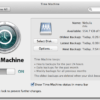

How to restore data from Time Machine
Now that you’ve been using Time Machine regularly to back up your computer, you should be fully prepared if your Mac crashes or if you need to move data from one Mac to another. Restoring data from Time Machine is just as easy as backing things up in the first place.
Apple recently released a Supplementary Update for OS X Lion users that fixes a Time Machine restore bug, so make sure your system is up-to-date with OS X Lion 10.7.3.
This how-to is done using an external hard drive dedicated to Time Machine, a Mac that performs regular Time Machine backups, and an additional Mac to demonstrate how to move data from one Mac to another.
Restore a single file or folder
If you’re just looking for a certain file or folder, start by connecting your drive and launching Time Machine. Choose Enter Time Machine. All of your saved backups will appear in chronological order, and you can use the visual timeline on the right hand side to scroll through your backups to look for specific items or folders. Older dates are indicated in pink, which show data saved on your backup drive, and the most updated data on your Mac is indicated in white (hint: It says “Now” in bold, white letters).
If you’re not exactly sure when the backup was performed that you’d like to access, you can perform a Spotlight search in Time Machine based on keywords.

Once you find what you’re looking for, use Quick Look to preview the file to make sure it’s the one you want (just highlight the file and click the space bar to bring up a quick look without having to launch the application).
When you’re sure you have the proper backup, select the file or folder and hit the Restore button. The file will automatically be copied to your desktop or to its original folder. This may take some time, depending on the size of the transfer.
Restore an entire system

If you’re restoring your entire system from a backup—in the event of a crash or if you wanted to start over from a specific backup—connect your Time Machine drive, and start up your Mac from the Lion recovery partition by holding Command-R at startup. (Or, if you have one, you can use your Mac OS X installation disk.)
A window called Mac OS X Utilities will appear. Select Restore from Time Machine Backup.
Select your Time Machine drive, then the backup you want to restore from, and then select your destination drive—the hard drive on your Mac. (Using Recovery Mode erases your Mac’s hard drive before restoring from Time Machine, but once the process is finished, you’ll be able to log in and use your Mac normally).
Transferring data between Macs
Let’s say you bought a new Mac and want to restore data from your old system, or you want to transfer data from one Mac to another. Use a utility called Migration Assistant. Once your backup drive is connected, go to Finder -> Applications -> Utilities, then open Migration Assistant. An intro to Migration Assistant will ask how you want to transfer your information, so click “From another Mac, PC, Time Machine backup, or other disk,” and then Continue.
Next, you’ll be asked to select your Migration Method—click “From a Time Machine backup or other disk.”
Select your backup drive, then choose which items you’d like to Migrate. Click Continue, and your files will begin to transfer.
